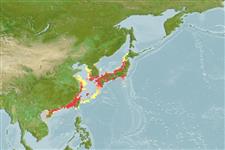Environment: milieu / climate zone / depth range / distribution range
Écologie
marin; saumâtre. Temperate
Northwest Pacific: southern Japan, Taiwan and from Fujian south to the Gulf of Tong King. Questionably from the Western Central Pacific (Ref. 47581).
Taille / Poids / Âge
Maturity: Lm ? range ? - ? cm
Max length : 25.0 cm TL mâle / non sexé; (Ref. 48635)
Épines dorsales (Total) : 8; Rayons mous dorsaux (Total) : 16; Épines anales: 3; Rayons mous anaux: 14. Deep-bodied, dark blotch on nape with highly reflective silvery areas next to it (Ref. 48635).
Found in shallow coastal and brackish waters (Ref. 41299, 48635). Aggregates in schools. Utilized as a food fish (Ref. 637). Commonly caught by anglers (Ref. 637). Produces sound (Ref. 9137).
Life cycle and mating behavior
Maturité | Reproduction | Frai | Œufs | Fécondité | Larves
Kimura, S., R. Kimura and K. Ikejima, 2008. Revision of the genus Nuchequula with descriptions of three new species (Perciformes: Leiognathidae). Ichthyol. Res. 55:22-42. (Ref. 74926)
Statut dans la liste rouge de l'IUCN (Ref. 130435: Version 2024-1)
Menace pour l'homme
Harmless
Utilisations par l'homme
Pêche sportive: oui
Outils
Articles particuliers
Télécharger en XML
Sources Internet
Estimates based on models
Preferred temperature (Ref.
123201): 16.5 - 26.6, mean 22.4 °C (based on 110 cells).
Phylogenetic diversity index (Ref.
82804): PD
50 = 0.5078 [Uniqueness, from 0.5 = low to 2.0 = high].
Bayesian length-weight: a=0.01259 (0.00787 - 0.02013), b=3.03 (2.89 - 3.17), in cm total length, based on LWR estimates for this species & (Sub)family-body (Ref.
93245).
Niveau trophique (Ref.
69278): 3.0 ±0.25 se; based on food items.
Résilience (Ref.
120179): Haut, temps minimum de doublement de population inférieur à 15 mois (K=2.56).
Fishing Vulnerability (Ref.
59153): Low vulnerability (15 of 100).
